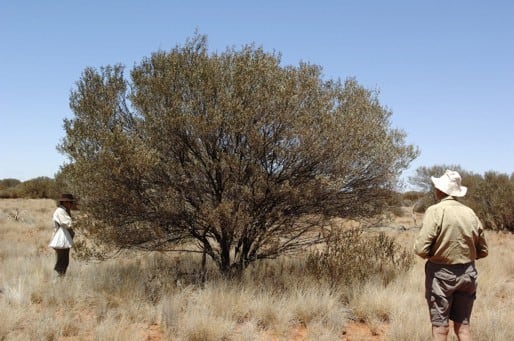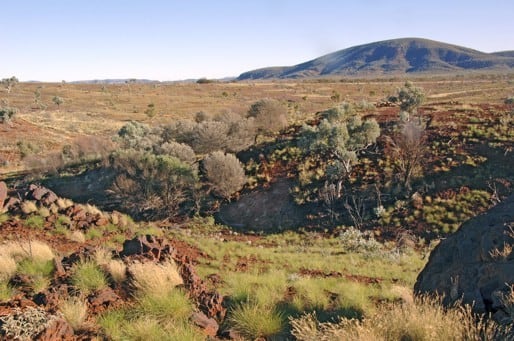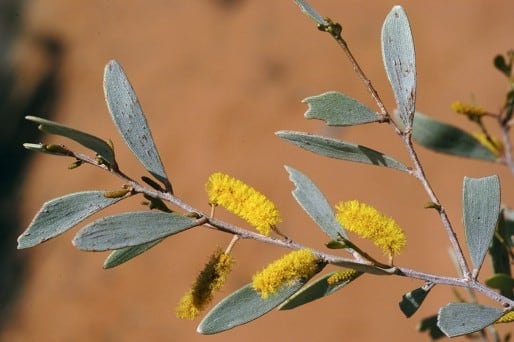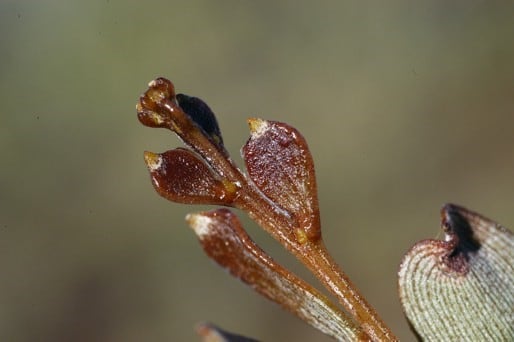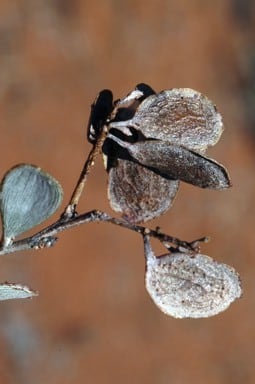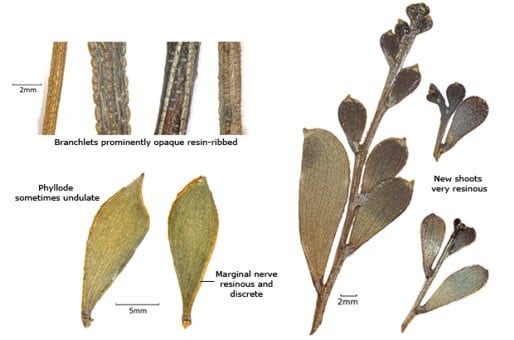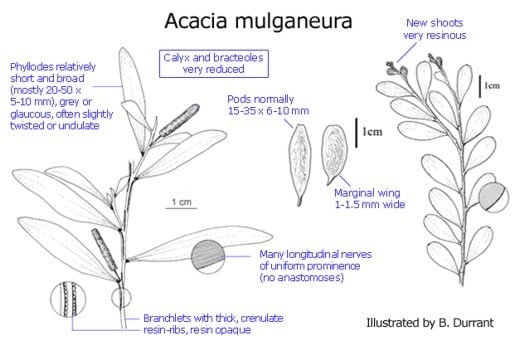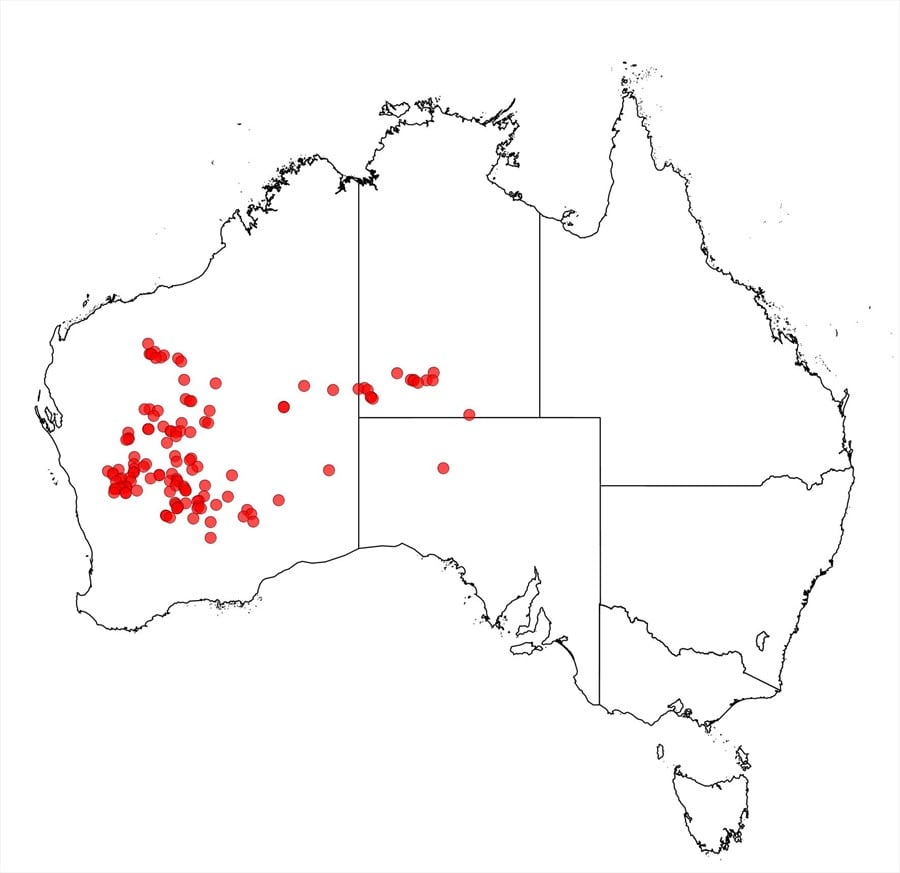Acacia mulganeura Maslin & J.E.Reid
WATTLE
Acacias of Australia
Common Name
Milky Mulga, Hilltop Mulga
Family
Fabaceae
Distribution
Widespread in W.A. extending from near Kalgoorlie and Paynes Find N to the southern Pilbara region, with a few scattered occurrences in the far E of the State; also occurs in NW S.A. and southern N.T.
Description
Rounded, multi-stemmed shrub commonly 1.5–3 m high, maturing to tree 4–5 (–7) m, crown often compact. Branchlet ribs with a thick layer of opaque, segmented, milky blue-grey or yellowish resin that often persists as beaded white lines on mature branchlets; new shoots very resinous, reddish glandular hairlets embedded within the opaque resin. Phyllodes variable, symmetrically elliptic to narrowly elliptic or obovate to oblanceolate, often slightly twisted or shallowly undulate, straight, (1–) 2–5 cm long, 5–10 (–13) mm wide, normally obtuse, grey, blue-grey, sub-glaucous or pale grey-green, dull green on oldest phyllodes, longitudinal nerves numerous, marginal nerve resinous and yellow to light brown. Inflorescences simple or occasionally rudimentary racemes to c. 2 mm long; peduncles 3–10 mm long, sparsely appressed white-puberulous with some red-brown, microscopic glandular hairlets; spikes 10–20 mm long; bracteoles minute (0.4–0.5 mm long) and sub-sessile. Flowers 5-merous; sepals often extremely reduced, 1/6–⅓ length of petals, ±free; petals 1.2–1.3 mm long. Pods oblong or fusiform, (1–) 1.5–3.5 cm long, (5–) 6–10 (–11) mm wide including wings 1–1.5 mm wide, firmly chartaceous to thinly coriaceous, dark greyish brown, obscurely longitudinally reticulate. Seeds oblique or sometimes longitudinal, 4.5–5.5 mm long, 2.5–3.5 mm wide, elliptic; aril small, creamy white.
Habitat
Grows in red-brown loam, sandy loam, silty loam, clay-loam or sometimes clay often over hardpan, on flats, gently undulating country or in skeletal soil on rocky hills. Often found in mixed Mulga shrubland with a ground cover of Spinifex (Triodia sp.).
Specimens
W.A.: Mt Beadell, Gibson Desert, S.D.Hopper 2814 (PERTH); 50 km W of Wiluna on rd to Meekatharra, B.R.Maslin 7077 (CANB, PERTH); c. 7 km due E of Giles Point (between Newman and Tom Price), B.R.Maslin & J.E.Reid BRM 10037 (K, PERTH). N.T.: Beddome Ra., New Crown Station, P.K.Latz 6873 (PERTH ex DNA). S.A.: 4 km N of SW corner of Lake, Wilkinson Lakes, F.Mollenman 967 (AD).
Notes
Plants of this species appear to be killed by fire.
Acacia mulganeura is a member of the ‘A. aneura group’ (Mulga) and is most closely related to A. caesaneura, A. incurvaneura (with which it sometimes hybridizes) and A. minyura; it also appears to have some affinities with A. ayersiana with which it may possibly occasionally hybridize in the Pilbara region, W.A. (e.g. B.R.Maslin 8087, PERTH). Acacia mulganeura is, however, distinguished from these species, and from all others of the Mulga group, by a combination of its thick-resinous branchlet ribs (resin opaque), very resinous new shoots, relatively short and broad, symmetric phyllodes and very reduced calyces and bracteoles. See B.R.Maslin & J.E.Reid, Nuytsia 22(4): 235-244 (2012), for further discussion. Specimens of A. mulganeura with short phyllodes can be confused with A. craspedocarpa which is readily distinguished by its reticulately nerved phyllodes; the two species are not especially closely related.
Two variants, not included in the above description, are recognized within this species in W.A.; these entities may represent hybrids or intergrades between A. caesaneura and different morphotypes of A. mulganeura. Both variants differ from typical A. mulganeura in having less resinous new shoots and from A. caesaneura in having shorter and/or more symmetric phyllodes. The more common of these variants is A. mulganeura (variant 1)which occurs from about Paynes Find to Cue E to Laverton, but seems most common in the western part of this geographic range. See B.R.Maslin & J.E.Reid, Nuytsia 22(4): 235-244 (2012), for discussion.
Acacia mulganeura was included within the circumscription of A. minyura by B.Randell, J. Adelaide Bot. Gard. 14: 126 (1992), resulting in that author erroneously describing the phyllodes as reaching 10 mm wide. The Winnecke s.n. and P.K.Latz 6873 collections cited by L.Pedley, Fl. Australia 11B: 325 (2001) under A. minyura are also A. mulganeura, fide B.R.Maslin & J.E.Reid, loc. cit. The specimen A.A.Burbidge 4 that L.Pedley, Flora of Australia 11B: 322 (2001), cited under A. aneura var. argentea is A. mulganeura.
FOA Reference
Flora of Australia Project
Author
B.R.Maslin
This identification key and fact sheets are available as a mobile application:
URL: https://apps.lucidcentral.org/wattle/
© Copyright 2018. All rights reserved.



